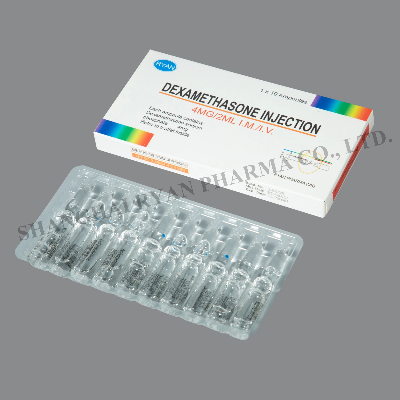Dexamethasone Sodium Phosphate Injection 4mg 2mlCOMPOSITION:Each
ampoule contains Dexamethasone sodium phosphate 4mg.PHARMACOLOGICAL
CLASSIFICATION:Corticosteroids and analogues.PHARMACOLOGICAL
ACTION:Dexamethasone phosphate acts by controlling the rate of
protein synthesis:It forms a steroid-receptor complex with receptor
proteins, moves into the nucleus where it binds the chromatin and
thus directs the genetic apparatus to transcribe RNA. It has a
biological half-life in plasma of about 190 minutes and has
relatively very weak sodium retaining
properties.INDICATIONS:Conditions where the anti-inflammatory and
immunosuppressive effects of a corticosteroid are desirable,
including intensive treatment during shorter
periods.CONTRA-INDICATIONS:Sensitivity to corticosteroids,
Tuberculosis, Ocular herpes simplex, Primary glaucoma, Acute
psychosis and psychoneurosis, Systemic infection, Peptic ulcer,
Osteoporosis.WARNING:Dexamethasone phosphate Injection should not
be administered intrathecally or subconjunctivally. Toxic effects
may result from withdrawal or from continued use of large doses.
Dexamethasone phosphate should be used with extreme caution in the
presence of congestive heart failure hypertension, in patients with
diabetes mellitus infectious diseases, chronic renal failure,
uraemia and in elderly patients.DOSAGE AND DIRECTIONS FOR USE:Usual
adult dosage ranges from 0.5 to 20 mg daily depending on the
severity of the disorder.Dexamethasone phosphate may be
administered intravenously or intramuscularly. The parenteral
administration must be reserved for administration in emergencies
or ad intensive therapy.Intra-articular, intralesional,
intra-muscular or soft-tissue injection: 0.8 to 4mg (depending on
the size of the joint).SIDE-EFFECTS AND SPECIAL
PRECAUTIONS:Dexamethasone phosphate has little or no effect on
sodium and water retention. Oedema, hypertension and an increased
excretion of potassium with the possibility of hypokalaemic
alkalosis may occur Cardiac failure may be induced.Excessive
metabolic effects may lead to mobilisation of calcium and
phosphorous, with osteoporosis and spontaneous fractures, nitrogen
depletion and hyperglycaemia with accentuation or precipitation of
the diabetic state. The insulin requirements of diabetic patients
are increased. Increased appetite is reported.The effect on tissue
repair is manifest in delayed wound healing and increased
susceptibility to all kinds of infection: including sepsis, fungal
and viral infections have been reported, especially if patients are
given antibiotics conjointly. Infections may also be masked.Acute
adrenal insufficiency may occur during prolonged treatment or on
cessation of treatment and may be precipitated by an infection or
trauma. Growth retardation in children has been reported. Large
doses may produce symptoms typical of hyperactivity of the adrenal
cortex with moon-face sometimes with hirsutism, buffalo hump,
flushing, increased bruising, striae, and acne, sometimes leading
to fully developed Cushing's syndrome. Sudden cessation of
administration is dangerous. Withdrawal should therefore always be
gradual, the rate depending upon the individual patient's response,
the dose, the disease being treated and the duration of therapy.
Adrenal function should be monitored throughout withdrawal and
symptoms attributable to over-rapid withdrawal should be countered
by resuming a higher dose and continuing the reduction at a slower
rate.Other adverse effects include amenorrhoea, hyperhidrosis,
mental and neurological disturbances, intracranial hypertension,
acute pancreatitis and aseptic necrosis of bone. Increase in the
coagulability of blood may lead to thrombo-embolic complications.
Peptic ulceration has been reported. Muscular weakness is an
occasional side-effect.Live vaccines should not be given to
patients receiving high-dose systemic corticosteroid therapy;
killed vaccines or toxoids may be given although the response may
be attenuated. Children are at special risk of infection and may
require prophylaxis and immunoglobulin. Patients receiving long
courses of dexamethasone phosphate should be regularly checked for
hypertension, glycosuria, hypokalaemia, gastric discomfort, and
mental changes.Sodium intake may need to be reduced and potassium
supplements may be necessary. Monitoring of the fluid intake and
output and daily weight records may give early warning of fluid
retention. Back pain may signify osteoporosis.Children are at
special risk from raised intracranial pressure. Infections should
be treated as an emergency.Large doses should be given slowly or by
infusion to prevent cardiovascular collapse.Concurrent
administration of barbiturates, phenytoin, or rifampicin may
enhance the metabolism and reduce the effects of dexamethasone
phosphate. Response to anticoagulants may be reduced or enhanced.
Concurrent administration with the potassium-depleting diuretics,
such as the thiazides or furosemide, may cause excessive potassiu
Related products about Dexamethasone Sodium Phosphate Injection 4mg 2ml
-
 Waste Tyre Plastic Recycling Machinery Machine Tire Crusher Production Line Rubber Crumb Grinding Machine Equipment Tire Shredder
Waste Tyre Plastic Recycling Machinery Machine Tire Crusher Production Line Rubber Crumb Grinding Machine Equipment Tire Shredder
-
 Stretch Plastic Blowing Pet Bottle Making Blow Molding Machine Bottles Stretch Automatic Pet Bottle Blowing Machine
Stretch Plastic Blowing Pet Bottle Making Blow Molding Machine Bottles Stretch Automatic Pet Bottle Blowing Machine
-
 Waste Plastic Pet Bottle, Water Bottle Flake, PP/HDPE/LDPE PE Film Jumbo Woven Bags Plastic Crusher Machine, Plastic Crushing Washing Recycling Machine
Waste Plastic Pet Bottle, Water Bottle Flake, PP/HDPE/LDPE PE Film Jumbo Woven Bags Plastic Crusher Machine, Plastic Crushing Washing Recycling Machine
-
 Type 2 Wall-Mounted Electric Car Charging Station 7kw /11 Kwelectric Vehicle Charging Station Home Wallbox AC EV Charger Single Phase or 3three Phase
Type 2 Wall-Mounted Electric Car Charging Station 7kw /11 Kwelectric Vehicle Charging Station Home Wallbox AC EV Charger Single Phase or 3three Phase
-
 G-View G12W Wholesale Auto Car LED Headlight Bulb High Power H13 H11 9005 H7 H4 Car LED Headlights LED Car Lights
G-View G12W Wholesale Auto Car LED Headlight Bulb High Power H13 H11 9005 H7 H4 Car LED Headlights LED Car Lights
-
 New Design Porcelain Round Plates Dinner Set for Wedding and Banquet
New Design Porcelain Round Plates Dinner Set for Wedding and Banquet
-
 China 2023 New Design Super Soft 100% Polyester Microfiber Knitted Oversized Decoration Hoodie Blanket
China 2023 New Design Super Soft 100% Polyester Microfiber Knitted Oversized Decoration Hoodie Blanket
-
 Handmade Art Creative Materials Thickened White Paper Cup DIY Disposable Handmade Colored Paper Cup
Handmade Art Creative Materials Thickened White Paper Cup DIY Disposable Handmade Colored Paper Cup



